| TR-606 | |
|---|---|
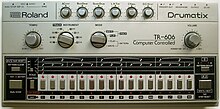 | |
| Manufacturer | Roland Corporation |
| Dates | 1981–1984 |
| Technical specifications | |
| Input/output | |
The Roland TR-606 Drumatix is a drum machine built by Roland Corporation from 1981 to 1984.
| TR-606 | |
|---|---|
 | |
| Manufacturer | Roland Corporation |
| Dates | 1981–1984 |
| Technical specifications | |
| Input/output | |
The Roland TR-606 Drumatix is a drum machine built by Roland Corporation from 1981 to 1984.
It uses analog synthesis rather than samples to produce sound. It imitates acoustic percussion: the bass drum, snare, toms, cymbal and hi-hat (open and closed). The sounds cannot be edited. [1] MusicRadar wrote that "the snare snaps and cracks, the kick offers a satisfying thud, and the metallic hats sizzle". [1]
Rhythms can be programmed using the sequencer, which includes controls for accents. [1] The sequencer can hold 32 patterns in memory, and patterns can be sequenced to create songs. [1] The TR-606 was designed to be used with the Roland TB-303 bass synthesizer, and can be synchronized using DIN sync. [1]
The TR-606 was used by artists including the Sisters of Mercy, Orchestral Manoeuvres in the Dark, Skinny Puppy, Big Black, Autechre, Aphex Twin and Luke Vibert. [1] Prince used it on the Purple Rain outtake "Velvet Kitty Cat". [2] The electronic musician Kid606 took his stage name from the TR-606. [3]

A drum kit is a collection of drums, cymbals, and sometimes other auxiliary percussion instruments set up to be played by one person. The drummer typically holds a pair of matching drumsticks or special wire or nylon brushes; and uses their feet to operate hi-hat and bass drum pedals.

Digital music technology encompasses digital instruments, computers, electronic effects units, software, or digital audio equipment by a performer, composer, sound engineer, DJ, or record producer to produce, perform or record music. The term refers to electronic devices, instruments, computer hardware, and software used in performance, playback, recording, composition, mixing, analysis, and editing of music.
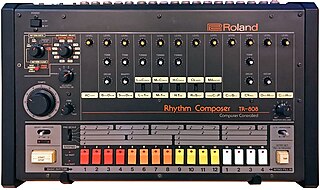
The Roland TR-808 Rhythm Composer, commonly known as the 808, is a drum machine manufactured by Roland Corporation between 1980 and 1983. It was one of the first drum machines to allow users to program rhythms instead of using preset patterns. Unlike its nearest competitor at the time, the more expensive Linn LM-1, the 808 generates sounds using analog synthesis rather than by playing samples.

A groovebox is a self-contained electronic or digital musical instrument for the production of live, loop-based electronic music with a high degree of user control facilitating improvisation. The term "Groovebox" was originally used by Roland Corporation to refer to its MC-303, released in 1996. The term has since entered general use, and the concept dates back to the Movement Computer Systems Drum Computer in 1981 and Fairlight CMI Page R in 1982.

Beatboxing is a form of vocal percussion primarily involving the art of mimicking drum machines, using one's mouth, lips, tongue, and voice. It may also involve vocal imitation of turntablism, and other musical instruments. Beatboxing today is connected with hip-hop culture, often referred to as "the fifth element" of hip-hop, although it is not limited to hip-hop music. The term "beatboxing" is sometimes used to refer to vocal percussion in general.

The Roland TR-909 Rhythm Composer, commonly known as the 909, is a drum machine introduced by Roland Corporation in 1983, succeeding the TR-808. It was the first Roland drum machine to use samples for some sounds, and the first with MIDI functionality, allowing it to synchronize with other devices. Though a commercial failure, it influenced the development of electronic dance music genres such as techno, house and acid house.

The Roland MC-303 is the first of a series of musical instruments known as a groovebox. It combines a simple sound module with a sequencer to record and store notation, along with controls aimed at encouraging the musician to improvise the music while it is playing. Despite the number in its name and the attention it received at its launch, the MC-303 has more in common with other MC prefixed synthesizers, which contain built-in sequencers, than it does with the famous Roland TB-303. As the first Groovebox, the MC-303 was the first in a line of inexpensive products specifically targeted towards house DJs and amateur home musicians rather than professional producers. It was superseded by the Roland MC-505. It is the predecessor to the Roland JX-305, Roland D2, Roland MC-307, Roland EG-101, Roland MC-09, Roland MC-909, Roland MC-808, and most recently the Roland MC-707 in 2019, along with its more portable sibling, the Roland MC-101.
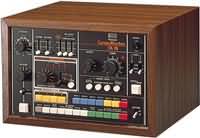
The Roland CompuRhythm CR-78 is a drum machine manufactured by Roland Corporation that was released in 1978. Although primitive by later standards, the CR-78 represented an important advance in drum machine technology at the time, in particular by allowing users to program and store their own drum patterns.
Tadao Kikumoto is Roland's senior managing director and head of its R&D center. He designed the TB-303 bass synthesizer and the TR-909 drum machine. He was also the chief engineer of the Roland TR-808 drum machine.

Electronic drums are a modern electronic musical instrument, primarily designed to serve as an alternative to an acoustic drum kit. Electronic drums consist of an electronic sound module which produces the synthesized or sampled percussion sounds and a set of pads, usually constructed in a shape to resemble drums and cymbals, which are equipped with electronic sensors to send an electronic signal to the sound module which outputs a sound. Like acoustic drums, the pads are struck by drum sticks and they are played in a similar manner to an acoustic drum kit, albeit with some differences in the drumming experience.

The Roland MC-505 is a groovebox conceived in 1998 as a combination of a MIDI controller, a music sequencer, a drum machine, and a desktop synthesizer with many synthesis features: arpeggiator, oscillators, and voltage-controlled filter, control of attack, decay, sustain and release, different envelopes and 2 Lfo. It was released as the successor to the Roland MC-303 and is a compact version of the Roland JX-305 Groovesynth without the full set of 61 keys. It is also the predecessor to the Roland D2, Roland MC-307, Roland MC-909 and the Roland MC-808.

The Roland TR-505 rhythm composer is a drum machine and MIDI sequencer released by Roland Corporation in 1986. It hails from the same family of drum machines as the Roland TR-909, TR-808, TR-707, TR-626 and TR-606. The drum kit includes basic rock drum sounds similar to those of the TR-707, plus a complement of Latin-style drum sounds similar to those of the TR-727
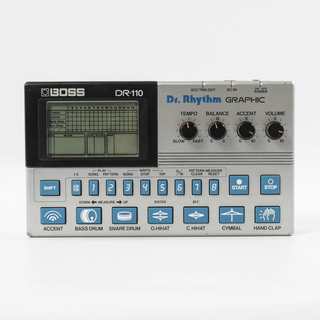
The Boss DR-110 Dr. Rhythm is a drum machine introduced in 1983 by the Boss product division of the Japanese Roland Corporation. It was the second entry in their DR series, following up on the much simpler DR-55.

The Soccergirl is an EP by electronic music artist Kid606, released in April 2000 through Carpark Records. It is the second release in Carpark's "sports-FAN" series following Jake Mandell's The Placekick. Its packaging included a compact disc designed to look like a soccerball, and soccer-field surface inspired traycard.

The Roland TR-707 Rhythm Composer is a drum machine released by Roland Corporation in 1985.
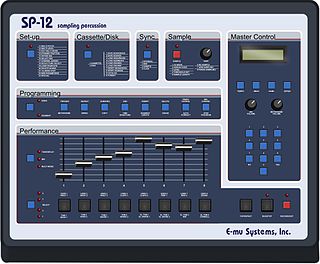
E-mu SP-12 also known as the “sampling drum computer” was designed in 1985 and widely released in 1986 by E-mu Systems. Although the SP-12 was quickly superseded by the more powerful SP-1200, the SP-12 is often regarded as the first commercially successful drum machine and sampler combo.
The Boss DR-220 Dr. Rhythm is a series of two budget-priced digital drum machines developed and manufactured by Boss Corporation beginning in 1985.

The Volca Beats is a hybrid drum machine produced by the Japanese music technology manufacturer Korg. It was released in April 2013 along with the Volca Keys and Volca Bass. The Volca Beats uses both analogue synthesis and PCM samples to produce drum sounds. It is part of Korg's Volca line of affordable synthesizers and drum machines, it has a 16-step sequencer and can run off batteries.
Aira Compact is a series of portable electronic musical instruments released by the Japanese company Roland. Originally released on 10 May 2022, the series currently comprises four models: the T-8, a drum machine; J-6, a synthesiser; E-4, a vocal effects unit, and S-1, a synthesiser that was released a year later in May 2023.